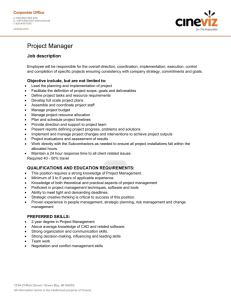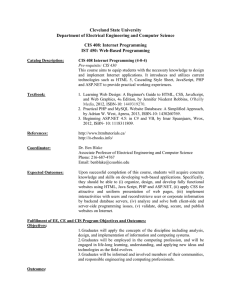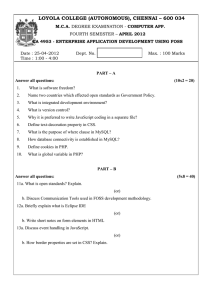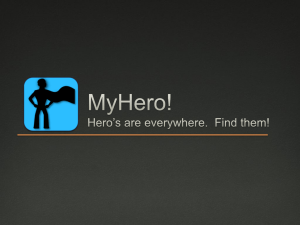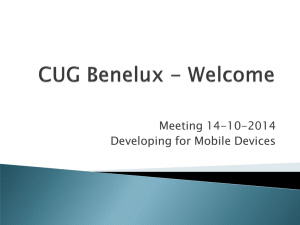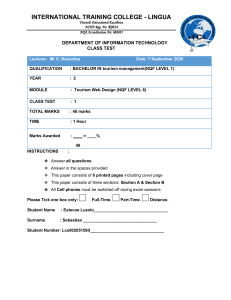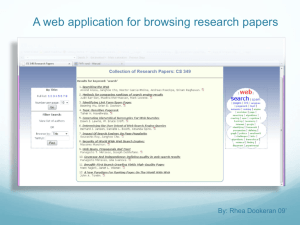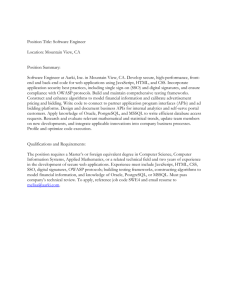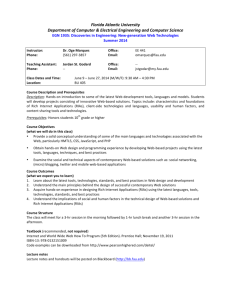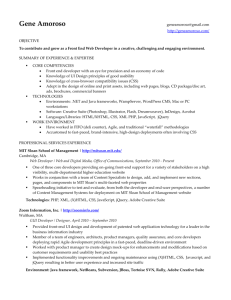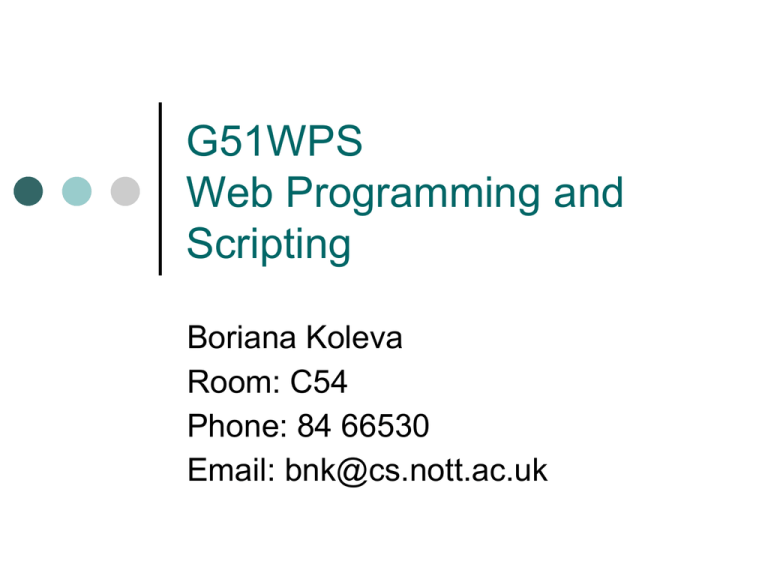
G51WPS
Web Programming and
Scripting
Boriana Koleva
Room: C54
Phone: 84 66530
Email: bnk@cs.nott.ac.uk
Introduction
Module goals, structure and contents
Practical matters
Initial introduction to some key ideas
and issues, historical context
Course Goals
A general understanding of the
fundamentals of the Internet and WWW
Knowledge and experience with the major
web technologies
Introduction to terms and acronyms
Insight into what constitutes a well
designed, usable web application
Course Contents
Infrastructure
• Networking basics:
media, LANs and long
distance comms
• TCP/IP protocols
• Client server paradigm,
HTTP protocol, URLs,
MIME types
Web Programming
•
•
•
•
•
HTML/XHTML
CSS
JavaScript
PHP
XML
Web Design
Lectures
Two lectures per week
• Tuesday 11:00-12:00 in LT2 Exchange
Building
• Thursday 11:00-12:00 in C33 Exchange
Building
Assessment
Coursework - 25%
•
•
•
•
Web application programming + report
Set: 17 February
Due: 30 March
Mark + feedback: 4 May
Exam - 75%
• Two hour written examination
• Previous papers (+ sample exam paper)
useful for revision
Labs
5 labs
• Monday 10:00-12:00 in A32 Computer
Science Building
• Not every week!
4 informal exercises to gain experience
with web technologies and 1 session for
assistance with coursework
Lab Schedule
Lab 1: 14 February – HTML
Lab 2: 21 February – HTML and CSS
Lab 3: 28 February – JavaScript
Lab 4: 14 March – PHP exercise
Lab 5: 21 March – assistance with formal
coursework
Text books and notes
Slides available from:
http://www.crg.cs.nott.ac.uk/~bnk/Teaching/WPS/
Recommended Text
• Programming the World Wide Web, 4th
edition, Robert W. Sebesta, 2008, Pearson
Addison Wesley
• Latest 6th international edition, 2010
• updated ASP.NET, updated Java web
programming, new chapter on Flash
Enabling Infrastructure
Networks and Communications
The Internet
The World Wide Web
Computer Communications
Early computers (1950s and early 1960s)
were isolated
Remote access and peripherals
• Connected to a central computer via dedicated
lines or telephone system
• Share resources
From the late 1960’s onwards computers were
connected to other computers
• Via dedicated lines or telephone system
• Share information
The Internet Origins
ARPA Networking Project (ARPANET) - late 1960s and
early 1970s
•
•
•
•
Wide area network to share computing facilities
“Internetworking”
Network reliability
For ARPA-funded research organizations
National Science Foundation internet (NSFnet) - 1986
• Initially connected five supercomputer centres
• By early 1990s it was the network for all
• Became the Internet backbone
In 1990’s ban on commercial use of the Internet was lifted
leading to an explosive growth of “e-commerce”
The Internet and the WWW
The WWW is one service running over the
Internet - it is not synonymous!
Before the WWW
• The Internet was used by scientists,
researchers, large (usually governmental)
organisations, and amateur enthusiasts
• Commerce on the Internet was almost
unknown
The WWW is now the major conduit to the
Internet and the major vehicle for ecommerce, but this is not what it was
designed for!
The WWW
Allows a user anywhere on the Internet to
search for and retrieve documents
1989 WWW proposal by group led by Tim
Berners-Lee at CERN
Late 1990 prototype implemented on NeXT
1991 WWW released to the rest of the world
Documents in the form of hypertext
Hypertext
“Non-linear reading and writing”
Ted Nelson
A page
of text
A page
of text
A page
of text
A page
of text
A page
of text
A page
of text
A page
of text
A page
of text
A page
of text
A page
of text
A page
of text
A page
of text
A page
of text
A page
of text
A page
of text
A page
of text
World Wide Web
HTTP Server
Apache
MS IIS
Client
Mozilla Firefox
MS Internet Explorer
HTTP
HTML data
Web Programmer’s Toolbox
HTML/XHTML
CSS
XML
JavaScript
PHP
Web application frameworks - Ruby on
Rails, TurboGears, CakePHP, ASP.NET
HTML
Describes the general form and layout of
documents
An HTML document is a mix of content and
controls
• Controls are tags and their attributes
• Tags often delimit content and specify
something about how the content should be
arranged in the document
• Attributes provide additional information about
the content of a tag
CSS
A language for defining stylesheets that
was developed for HTML
Provide the means to control and change
presentation of HTML documents
Style sheets allow you to impose a
standard style on a whole document, or
even a whole collection of documents
XML
A meta-markup language
Used to create a new markup language
for a particular purpose or area
Because the tags are designed for a
specific area, they can be meaningful
No presentation details
A simple and universal way of
representing data of any textual kind
JavaScript
A client-side HTML-embedded scripting
language
Only related to Java through syntax
Dynamically typed and not objectoriented
Provides a way to access elements of
HTML documents and dynamically
change them
PHP
A widely used server-side scripting
language
Similar to JavaScript
Great for form processing and database
access through the Web
Free software released under the PHP
License
Summary
Course Content
Practical matters
Introduction to infrastructure
• Computer communications
• Internet
• WWW
Introduction to the web programmer’s toolbox
• HTML
• CSS
• XML
• JavaScript
• PHP

